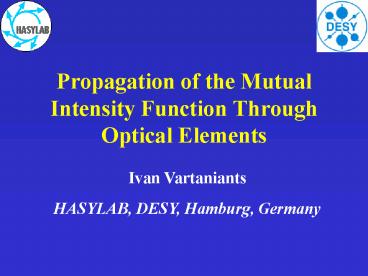Propagation of the Mutual Intensity Function Through Optical Elements PowerPoint PPT Presentation
1 / 48
Title: Propagation of the Mutual Intensity Function Through Optical Elements
1
Propagation of the Mutual Intensity Function
Through Optical Elements
Ivan Vartaniants HASYLAB, DESY, Hamburg, Germany
2
CONTENTS
- Introduction
- Coherent X-ray Diffraction Experiments
- Problems
- Propagation of MIF from Source to Sample
- Problems
- Propagation of MIF Through Optical Elements
- Measurements of Coherence
- Links to Laser Sources
- Conclusions
3
Lensless X-ray Microscopy
4
Imaging of biomolecules with femtosecond X-ray
pulses
Explosion of T4 lysozyme induced by radiation
damage
R. Neutze, et al., Nature (2000) 406, 752
5
Imaging of Biomolecules with Femtosecond X-ray
Pulses
Simulated continuous scattering image of a single
T4 lysozyme molecule under ideal conditions
without sample movement or damage.
R. Neutze, et al., Nature (2000) 406, 752
6
Coherent Scattering on Au Crystals
- 4 micron Au nanocrystal
- Coherent X-ray Diffraction
- Measurement at APS sector 33-ID (UNICAT)
I. Robinson, I. Vartanyants, et al., PRL (2001),
87, 195505
7
Coherent Diffraction Tomography
G. Williams et al., PRL (2003) 90, 175501
8
Definitions
P1
S
P2
L1
9
Laws of Propagation of Mutual Intensity Function
R2
Can be further calculated using paraxial
approximation
10
Sources
11
Van Zittert-Zernike Theorem
Sample
Source
R1
s
R2
L
r
MIF from an incoherent source is a FT of
intensity distribution from this source
12
Synchrotron source
Intensity distribution (Gaussian)
Single Gaussian function can fully describe
coherence properties of the Gaussian source
13
Synchrotron source
14
Imaging Experiment (small crystals)
Diffracted intensity (partial coherent
illumination)
projection of shape function of particle s(r,z)
15
Imaging of small crystals(partial coherent
illumination)
MIF J (?r) on sample position
diffracted intensity I(Q)
reconstructed crystal images
I. Vartanyants I. Robinson. J.Phys. Condens.
Matter (2001) 13, 10593
16
Optics
17
Optical Components on a Typical Beamline
Source
Sample
How coherent properties of the beam are modified
passing through all these elements?
Start to End Calculations
18
Propagation of MIF through an Optical Element
Optical Element
Ein
Et
u
Transmitted amplitude
T(u) amplitude transmittance function
19
Propagation of MIF through an Optical Element
Optical Element
Sample
Source
R1
R2
s
r
u
L1
L2
Coherence properties of the beam in general are
modified passing optical elements in the beamline
20
Limits of Coherent and Incoherent Illumination
Coherent illumination
MIF factorizes
Phase object just after incoherent source does
not change coherence
21
Propagation of MIF through an Optical Element
- Two ways to proceed
- To take an 'exact' model for an optical
element - To use statistical approach
22
1-st approach Transmittance Function
Complex transmittance function
23
2-nd approach Propagation of MIF through a
random OE
- Assumptions
- Optical element (Be window, mirror) considered as
a random optical element - Partial coherent incoming beam
- Transverse coherence length of the incoming beam
is smaller then the intensity distribution
?inltlt?eff
24
Autocorrelation function for random phase object
- Assumptions
- Gaussian statistics
- Stationary random process
25
Propagation of MIF through a random OE
Undistorted part
Rescattered part
26
Propagation of MIF through a random OE
Source (ssx, ssy)
Sample
JS(r1,r2)
Be window (swx, swy)
JW(r1,r2)
L1
L2
I. Vartanyants I. Robinson. Opt.Comm. (2003)
222, 29
27
Complex Coherence Factor ? (?r)?1.5 Å, L26 m
?2?0.5 ?1 ?m
?2?0.1 ?1 ?m
?2?0.5 ?0.1 ?m
?2?0.5 ?1 ?m
CCF can not be described by single Gaussian
function
The whole shape of the CCF is important not
only averaged characteristics (first, second,..
moments)
28
Imaging of small crystals(partial coherent
illumination)
29
Coherence measurements
F. Pfeiffer et al., Phys. Rev. Lett. (2005) (to
be published)
30
Coherence measurements
31
FEL and Laser Sources
Amplitude of electric field
Only laser in single mode operation will be
completely transverse coherent
32
Coherence Properties of FEL
Averaged efficiency lt?gt of SASE FEL versus
undulator length
Degree of transverse coherence ? of the radiation
from SASE FEL
E. Saldin, E. Schneidmiller, M. Yurkov, NIM A
(2003), 507, 106
?1/M
33
Coherence Properties of Multimode Laser
34
CONCLUSIONS
- For CXD imaging experiments full transverse
coherent beam is desirable (artifacts in
reconstruction) - For partially coherent beams coherence properties
can be affected by the presence of the optics in
the beamline - For FELs coherence properties of the x-ray beam
can be, in principle, calculated starting from
the undulator to sample position (Start to End
calculations) - Expected coherence properties of the FEL in
multimode regime will be similar to incoherent
source
35
Thank you for your attention
36
(No Transcript)
37
Coherence
LL?2/(2? ?)
Longitudinal Coherence Length
Als-Nielsen McMorrow (2001)
38
Propagation of MIF through Be window
Yabashi et al., J.Phys. D (2004), to be published
39
3D Scan of the Reciprocal Space
G. Williams et al., PRL (2003) 90, 175501
40
Coherence and Partial Coherence
R1
P
P1
R2
P2
S
D
L1
L2
41
Coherence and Partial Coherence
?12(?)1 coherent scattering ?12(?)
0 incoherent scattering 0lt?12(?)lt1
partial coherent scattering
42
Intensity distribution
Solution We have to replace real source with an
effective source with an effective coherence
length (generalized van Zittert-Cernike theorem)
43
Intensity distribution
?s
?s
?sltlt?s
44
Intensity distribution
MIF at sample position (in the far-field)
45
Synchrotron source
46
Iterative phase retrieval algorithm
FFT
sk(x)
Ak(q)
Reciprocal Space Constraints
Real Space Constraints
A'k(q)
s'k(x)
FFT-1
Real space constraints
Reciprocal space constraint
- finite support
- real, positive
J.R. Fienup, Appl Opt. (1982). 21, 2758 R.P.
Millane W.J. Stroud, J. Opt. Soc. Am. (1997)
A14, 568
47
2-nd approach Propagation of MIF through a
random OE
- Assumptions
- Optical element (Be window, mirror) considered as
a random optical element - Partial coherent incoming beam
- Transverse coherence length of the incoming beam
is smaller then the intensity distribution
?inltlt?eff
48
Examples

